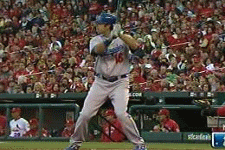
A little over five years ago one of the best draft classes in Major League Baseball history was crafted, where the first round was littered with an almost hyperbolic amount of talent. While several of those players taken in the first round have established themselves in the Major Leagues, including a few who are already MVP candidates, two of the Top 5 draft picks have yet to live up to the lofty expectations that come with being a Top 5 pick. Few doubted the tools of No. 2 overall pick Alex Gordon and No. 3 overall pick Jeff Clement coming out of the draft, but big questions have arisen on their ability to use their prodigious tools at the Major League level. In the first part of this two-part series, I'll examine Alex Gordon's struggles to surface as an above-average regular
*Note, this isn't to second guess the selections, but rather examine what is holding back these two players from fulfilling their potential.
When the Kansas City Royals drafted University of Nebraska third baseman Alex Gordon, the word "savior" and the name "George Brett" were thrown around almost immediately.
Gordon continued putting up the numbers he showed in college along with his prodigious talent and tools at Double-A Wichita, where he posted a .325/.427/.588 line with 29 home runs, 101 RBI's and 22 steals on his way to winning Baseball America's 2006 Minor League Player of the Year award.
But Gordon has yet to come close to those numbers at the Major League level. While he's shown glimpses from time to time, injuries and a lack of consistency have hurt his overall production and development.
Taking a look at Gordon's swing, some inefficiencies jump out as reasons why he hasn't quite turned out to be the superstar most people had him pegged to be.
Not much changed from his rookie year in 2007 (left) and 2009 (right).

 Gordon has always been a guy who relied on raw strength and bat speed to get the job done, versus combining those two assets with technique and efficiency, which just about every great hitter does. No one can doubt his raw strength and bat speed, as that has never been an issue for him. But few hitters can rely on those tools alone at the Major League level, which is the ultimate proving ground for technique and efficiency.
Gordon has always been a guy who relied on raw strength and bat speed to get the job done, versus combining those two assets with technique and efficiency, which just about every great hitter does. No one can doubt his raw strength and bat speed, as that has never been an issue for him. But few hitters can rely on those tools alone at the Major League level, which is the ultimate proving ground for technique and efficiency.
Gordon's tools and talent allowed him to simply overpower college and Double-A pitching. He never had to learn to be efficient because he had never struggled.
Gordon's Swing
Gordon had a very upper body dominant swing when he first reached the Majors, and while he's learned to use his legs a little more over time, there still is inadequate hip involvement. Gordon has a small load and pulls forward with everything he's got with his bottom hand to deliver the barrel, which gives him good raw bat speed but it's of the late variety. Late meaning he generates the bulk of the barrel's velocity late and out front vs. doing more behind him a la Manny, Bonds, Pujols, etc. Since his bat speed is late, Gordon loses time to better judge the ball as it approaches the plate and his bat speed isn't as controlled as it could be.
Since Gordon is all pull with his lead arm, or a 'knob puller' as some call it, he doesn't use his top hand much. This costs him accuracy with his barrel and limits the adjustability of his swing plane. A small load and a hard yank forward means his swing quickness is very limited as well. Huge raw bat speed is great, but without quickness, Gordon is forced to do more work out in front instead of already having his barrel get up to speed behind him.
 Looking at his lower half, you can see how inefficient his weight shift is. In the clip to the left, which was a home run off a center-cut fastball, his rear leg is weighted before, during AND after his swing. His hips just turn/spin and don't offer all they could in terms of force/energy production. Gordon is the definition of a back-foot hitter.
Looking at his lower half, you can see how inefficient his weight shift is. In the clip to the left, which was a home run off a center-cut fastball, his rear leg is weighted before, during AND after his swing. His hips just turn/spin and don't offer all they could in terms of force/energy production. Gordon is the definition of a back-foot hitter.
(You can compare his weight shift to Mauer and Ethier below to see the differences. Hint: See whose rear hip, and specifically rear knee, explodes forward more.)
Another reason for his lack of a weight shift is how Gordon dives toward the plate with his front foot. It's gotten better now than in the front view 2007 clip from earlier, but still very noticeable. This traps his rear hip, not allowing it to explode and fire forward and forces him to work around his front hip with his backside. Since he has to work around his front hip, his swing plane is a little bit grooved to his pull side. This doesn't mean he can't hit to the opposite field well. It just means his energy is working around his body and thus around the ball, versus driving through the baseball. Gordon's lack of weight shift means his upper body has to do more work, resulting in more effort being used to swing, versus having the "effortless power" that the greats all achieve.
Swing Length
When you look closely at Gordon's hands, you'll see what may be his biggest inefficiency of all: the pure length of his swing. Take note of his hand action, once he decides to launch his swing. You can see the "grab" of his bottom hand start to take over and move the bat forward (knob pull), and see his hands start to flatten behind him. This is a "flatten-then-swing" move, or a two-part move that adds unnecessary length to his swing. Also take note of how much his hands move down before coming forward. This adds length to his barrel path, giving him a much wider and longer arc than the hitters below.


Compare the hand actions of Gordon to Joe Mauer and Andre Ethier's -- huge differences in swing length and when the flattening of the hands happens. Mauer and Ethier flatten and extend their hands forward in one move, which is more efficient than Gordon's hand movement. The frame rate of the Gordon clip and the Mauer and Ethier clips are slightly different (Gordon being slower) but you can still see the differences in quickness and change of direction. When Mauer and Ethier launch their swings, the flattening and extension are almost instantaneous. When they decide to launch, they're gone. Gordon's hand action results in him taking a longer time to deliver the barrel, and against 94 MPH, time is of the essence.
Conclusions
Gordon could get away with all of these inefficiencies (knob pull, long swing, inefficient weight shift) against college and Double-A competition because he has superstar talent, and still does. But inefficiencies get exploited at the Major League level, especially when the ones that he has are very tough to overcome. If Gordon used his top hand to flatten and extend forward in order to deliver the barrel along with a more efficient rear hip action, he'd be a completely different hitter. His quickness would improve, his barrel control would improve, and his consistency would be improved. Gordon wouldn't have to yank hard to produce bat speed, as his bat speed would come much easier and efficiently.
Stay tuned for Part II, where we take a look at Pirates first baseman Jeff Clement.
Follow Steve Carter on Twitter, or reach him at stevecarterpp@hotmail.com
